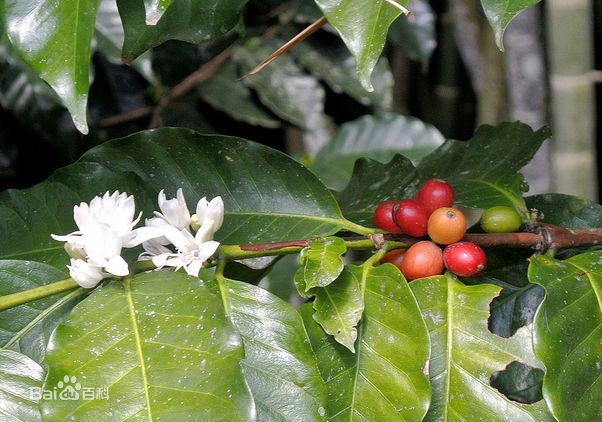Classification and causes of defective beans in SCAA Coffee SCAA level: Italian mixed beans with secondary defects
CAA level:
The whole sour bean is a first-class defect.
A whole sour bean = a complete flaw
Name of defect: local sour bean
SCAA level:
Local sour bean is a secondary defect.
Less than half of a bean is sour beans, 3 beans = 1 complete defect
Causes:
Agriculture and treatment. Sour beans are caused by fermentation, which is the result of contamination by microbacteria in many places in the process of harvest and treatment. Specific reasons include: picking overripe fruit, harvesting fallen fruit, water pollution during treatment, or excessive fermentation due to wet environment when the fruit is still attached to the tree.
Precautionary measures:
1) Agriculture: only pick ripe fruits (avoid overripe fruits), do not harvest fallen fruits, and do not grow coffee in low-altitude areas near rivers, lakes or dams to avoid over-fermenting coffee beans.
2) treatment: sour beans can be avoided by ensuring timely removal of pulp (immediately after picking to avoid delaying storage). When the whole water is washed, the fermentation time in the fermentation tank is controlled. Avoid pollution or recycling water in the process of washing out. Drying treatment should be completed in time and continuously. When coffee beans remove endocarp, sour beans are obvious, color classifiers and hand-selected classifiers can remove many parts of sour beans.
Defect name: mildew bean
SCAA level:
First-class flaw.
1 moldy bean = 1 complete defect
Causes:
Agriculture and treatment. Moldy beans are usually infected by Aspergillus and Penicillium fungi. Inappropriate temperature and humidity can cause Fusarium infection to coffee beans everywhere from picking to storage. It will induce mold growth. If mold spores appear, fungi will only grow under these conditions.
Precautionary measures:
1) Agriculture: coffee must be planted in producing areas with suitable temperature and humidity, this environment is also suitable for mold growth, and efforts must be made to inhibit the production of bacteria from mold sources. This includes harvesting fruits from the ground or severely moth-eaten, as well as coffee beans left in harvesting baskets and drying tanks.
2) treatment: good fresh fruit processing and shelling processing can prevent coffee infection. The causes of infection include coffee beans that break or break when the pulp is removed, leaving beans in the fermentation tank, delaying drying, interrupting the drying process, worming, and storing shelled beans in high humidity and high temperature.
3) Agronomy: only pick ripe fruits (avoid overripe fruits), do not harvest fallen fruits, and do not grow coffee in low-altitude areas near rivers, lakes or dams to avoid over-fermenting coffee beans. Moldy beans are obvious when coffee beans are shelled and endocarp removed. At this stage, the color classifier removes many parts of heavily moldy infected coffee beans, while slightly moldy beans can only be removed by hand.
Name of defect: foreign body
SCAA level:
First-class flaw.
1 foreign body = 1 complete defect
Causes:
Variety: foreign bodies can be produced in any process.
Precautionary measures:
1) Agriculture: none.
2) treatment: foreign bodies can be removed or avoided in the following ways:
Pay attention to branches and leaves when picking.
Pay attention to other substances, such as stones, sawdust, nails, etc., when drying in the sun.
In the shelling plant, use appropriate equipment, such as stone removers, magnets, to effectively remove foreign bodies.
Defective name: coffee dried fruit / dried pod
SCAA level:
First-class flaw.
1 dried fruit
Or dried pod = 1 complete defect
Causes:
1) Agriculture: drought and disease make the fruit dry on the trees and even fall to the ground.
2) treatment: in washed coffee, the presence of dried coffee fruits or dried pods is the result of a low-end pulp removal process and the failure of primary selection of floating beans (dried fruits) with water at the receiving station, and the equipment is not maintained or adjusted. In sun-treated coffee, the presence of dried fruits or pods is the result of inappropriate shelling and grading.
Precautionary measures:
1) Agriculture: avoid harvesting dried fruit from the ground or trees.
2) treatment: when there are too many dried fruits, the sheller can not be removed effectively. Removing all floating beans at the receiving station and maintaining the correct proofreading and maintenance of the pulp removal machine will reduce the production of dried fruit. Any dried pods that pass through the sheller can be selected and removed by a degree classifier during shelling processing.
Defective name: moth-eaten bean
SCAA level:
Serious borer bean is a first-class defect, 3 or more perforations
5 serious worm-eaten beans = 1 complete defect
SCAA level:
The pea is a secondary defect, with less than 3 perforations.
10 slight worm-eaten beans = 1 complete defect
Causes:
1) Agriculture: the berry bug is the most serious pest in coffee cultivation. The insect (coffee fruit bark beetle) pecks holes in coffee fruits and trees, digs channels in soft seeds and lays eggs. Newborn eggs usually appear from the other end, creating two holes in a coffee bean. It is not common to have multiple channels in a bean. The incidence of this disease often increases and decreases with altitude.
Precautionary measures:
1) Agriculture: the best way to avoid moth-eaten coffee is to observe and put an end to the breeding conditions of insect pests. Spraying is an option, but its impact is limited, requiring integrated pest management techniques (e.g. special design for fungal management) (Beauveria bassiana) and the use of African wasps, as pests multiply in seeds, it is necessary to pick up all coffee fruits that fall on the ground to eliminate the conditions for their reproduction and spread. In addition, the pulp of mature fruit can carry diseases and insects, so there should be a reasonable distance between the tree and complete composting. It is not feasible to identify healthy and moth-eaten fruits during picking, because the damage is generally internal and cannot be detected without very careful observation.
2) treatment: after being transported to the shelling processing plant, the moth-eaten coffee beans become obvious after the endocarp is removed. At this stage, the density classifier can remove many parts of the seriously moth-eaten beans. If the coffee is seriously infected, it should be selected by hand. Serious pest infection has a devastating effect on farmers, making it impossible to export most of the harvest.
Damage during wet grinding
Damage during dry grinding
Defect name: broken bean, broken bean, broken bean
SCAA level:
Secondary defect: 5 broken beans = 1 complete defect
Causes:
1) treatment: broken beans, broken beans or broken beans usually occur due to excessive friction or excessive pressure due to incorrect machine adjustment during pulp removal or shelling treatment.
Precautionary measures:
1) Agriculture: picking and handling only ripe fruits, because immature or immature fruits cannot correctly remove the pulp. Immature fruit cannot remove the flesh at all.
2) treatment: pay attention to adjust the pulp remover to avoid excessive pressure or friction on beans.
In the shelling plant, adjust the sheller to avoid bean friction, and use a density classifier and a size classifier to remove small broken beans or broken beans. Larger beans must be graded either by color classifier or by hand.
Defective name: unripe beans
SCAA level:
Secondary flaw.
5 unripe beans = 1 complete defect
Causes:
1) Agriculture: immature beans are not fully grown due to a variety of reasons, including improper picking of immature beans and uneven picking due to mature varieties at high altitudes.
Precautionary measures:
1) Agriculture: immature beans can be avoided by picking only ripe fruits, or early-maturing varieties can be cultivated at middle and high elevations.
2) treatment: unripe beans can be removed during fresh fruit processing and shelling processing. In the processing of fresh fruit, many unripe beans are distinguished by the number of eyes after removing the pulp. During shelling, many unripe beans can be removed by density classification, but many color classifiers cannot remove this flaw.
Name of defect: dead bean
SCAA level:
Secondary flaw.
5 beans = 1 complete defect
Causes:
1) Agriculture: the main cause of dead beans is the lack of water (drought) when coffee beans grow in fruit. The damage depends on the density and the duration of drought. If coffee plants are fragile or unhealthy, the risk of damage to beans is very high.
Precautionary measures:
1) Agriculture: maintain coffee trees to absorb nutrients properly and grow healthily to reduce damage. However, climate disorders, such as El Ni ñ o, can have devastating effects on crops. During the dry period, too many or wrong hidden trees compete with coffee trees for moisture in the soil.
2) treatment: the density of heavy dead beans is low and will float on the water surface. It can be removed in the early water cleaning process. During shelling processing, dead beans with small size and low density will be removed from the density classifier. The bigger and thicker dead beans need to be selected by hand.
Defective name: floating beans
SCAA level:
Secondary flaw.
5 floating beans = 1 complete defect
Causes:
1) treatment: this defect is caused by improper storage and drying. Beans with shells are usually left in the corner of the dryer or on the drying field, resulting in faded and low-density beans. Storage with shell beans can also produce floating beans under high humidity conditions.
Precautionary measures:
1) Agriculture: none.
2) treatment: shell beans must be evenly dried to a very suitable water content. During shelling, some low-density floating beans can be removed by density classifiers, but some high-density ones need to be selected by color classifiers and manual classifiers.
Defective name: shell bean
SCAA level:
Secondary flaw.
5 shell beans = 1 complete defect
Causes:
Agriculture: this is a natural phenomenon caused by heredity.
Precautionary measures:
1) Agriculture: select appropriate coffee varieties and optimize planting conditions.
2) treatment: during shelling processing, shell beans can be removed by density classification.
Defective name: shell bean
SCAA level:
Secondary flaw.
5 shelled beans = 1 complete defect
Causes:
Treatment: this defect occurs in the shelling process, which is caused by improper calibration of the sheller.
Precautionary measures:
1) Agriculture: none
2) treatment: when shelling, keep the sheller calibrated and maintained properly. Shell beans can be removed through a density classifier.
Name of defect: shell / peel
SCAA level:
Secondary flaw.
5 hulls = 1 complete defect
Causes:
1) treatment: the shell or peel usually appears in sun-treated coffee and is not properly cleaned. The calibration of the low-end peeling machine will produce fresh peel fragments, which will eventually be dried into a dried shell.
Precautionary measures:
1) Agriculture: none.
2) deal with:
Fresh fruit processing: correct calibration and adjustment of fruit removal machine
Shelling process: pay attention to the exhaust (air selection) process. Pay attention to the calibration and adjustment of the density classifier.

Important Notice :
前街咖啡 FrontStreet Coffee has moved to new addredd:
FrontStreet Coffee Address: 315,Donghua East Road,GuangZhou
Tel:020 38364473
- Prev

How to identify the quality of coffee beans? what is the cup test? Q professional baristas coffee bean quality
The cup test is very important for the taste of coffee beans, no matter how much the flavor of a bean is advertised, or how much the baking level is boasted, before it is offered to consumers on the shelves, have been judged by the cup test. The baking bean merchant will take the sample beans from the raw bean merchants, then test and bake them themselves, and then do the cup test in person.
- Next

Choose coffee cups, Italian lattes, espresso, spaghetti beans
Many baristas like the sharp mouth to pull the flower jar, feel that the mouth is sharp, the wall is thick, appear professional, buy one after another. They show off one after another on various occasions, but the probability of failure is very high, and some even use today's poor condition as an excuse. But in fact, because the exit of the pointed-mouth flower jar is deeper, it is more convenient to control the flow rate, and the force can be uniform in the rocking operation, so this kind of flower-pulling jar is made of fine type.
Related
- Beginners will see the "Coffee pull flower" guide!
- What is the difference between ice blog purified milk and ordinary milk coffee?
- Why is the Philippines the largest producer of crops in Liberia?
- For coffee extraction, should the fine powder be retained?
- How does extracted espresso fill pressed powder? How much strength does it take to press the powder?
- How to make jasmine cold extract coffee? Is the jasmine + latte good?
- Will this little toy really make the coffee taste better? How does Lily Drip affect coffee extraction?
- Will the action of slapping the filter cup also affect coffee extraction?
- What's the difference between powder-to-water ratio and powder-to-liquid ratio?
- What is the Ethiopian local species? What does it have to do with Heirloom native species?

